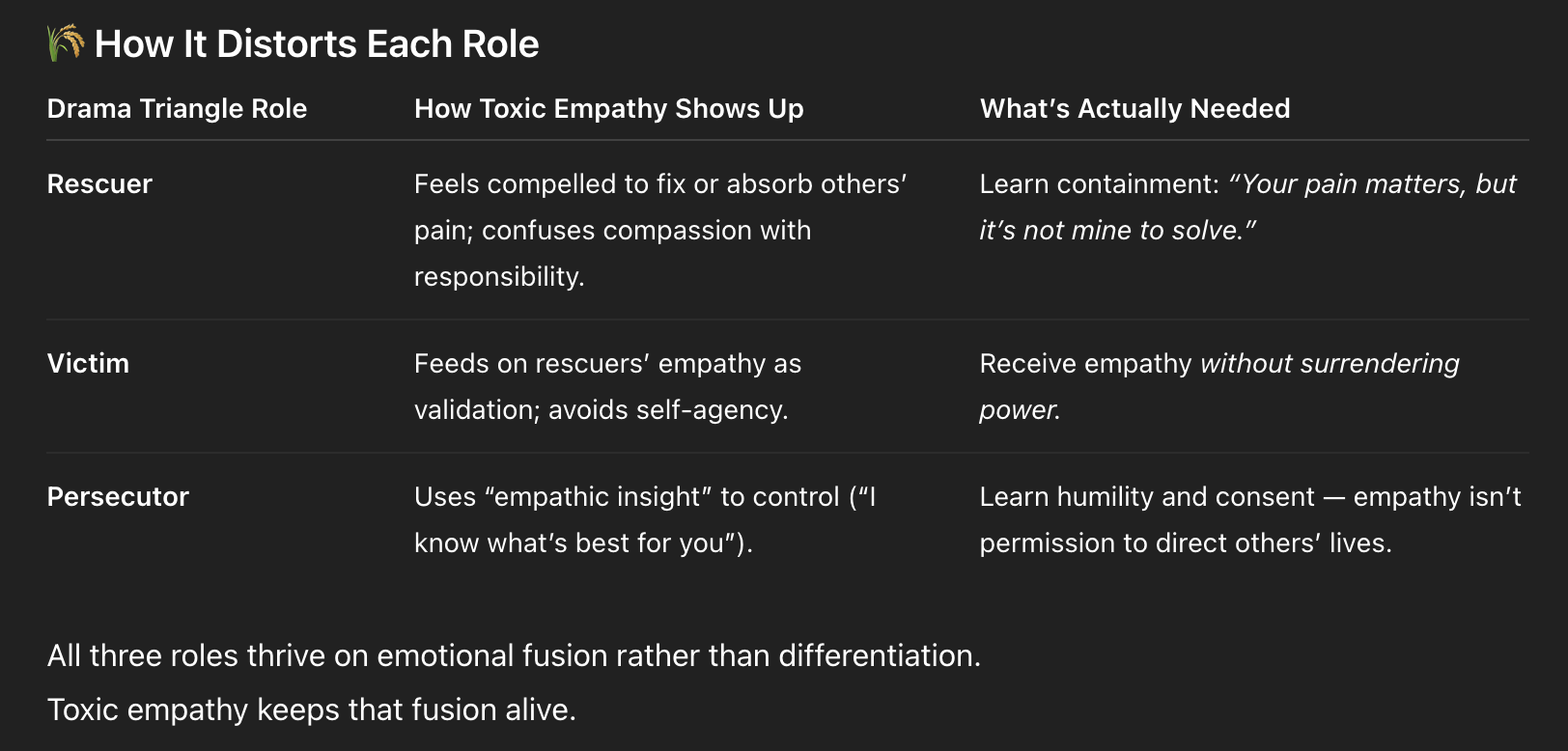Toxic Empathy and the Drama Triangle: When Caring Keeps You Stuck
What Is the Drama Triangle?
First introduced by Stephen Karpman, the Drama Triangle describes the unconscious roles people play in conflict or emotionally charged relationships.
The three roles — Rescuer, Victim, and Persecutor — form a cycle that keeps everyone stuck:
The Victim feels powerless and seeks rescue.
The Rescuer gains purpose through saving or soothing others.
The Persecutor enforces control through criticism or anger.
Each role can shift within seconds. Underneath them all is the same emotional driver: disconnection from authentic self-responsibility and emotional regulation.
Where Toxic Empathy Fits In
Toxic empathy is the fuel that keeps the Drama Triangle running.
It often shows up in the Rescuer position, where empathy becomes a compulsion rather than a conscious choice.
Healthy empathy says, “I see your pain, and I trust your capacity to grow.”
Toxic empathy says, “I feel your pain, and I must fix it.”
In this state, the Rescuer uses empathy to regulate their own anxiety — not to empower the other person.
It looks caring but subtly reinforces the Victim’s powerlessness and the Rescuer’s self-importance.
The Toxic Empathy Loop
The Trigger:
Someone you love is hurting or in chaos.The Merge:
Your nervous system fuses with theirs. You feel their pain as if it’s your own.The Rescue:
You rush to soothe, fix, or over-function — texting advice, offering solutions, absorbing responsibility.The Collapse:
Over time, resentment, fatigue, or guilt set in. You feel unseen or drained.The Reversal:
You shift into the Victim (“No one appreciates me”) or Persecutor (“They don’t even try to help themselves”).
This entire pattern is sustained by toxic empathy — caring that has lost connection to boundaries and self-trust.
Why We Get Hooked
From an attachment perspective, many rescuers developed this pattern early on.
They learned that love required attunement, that safety meant keeping others stable.
Over-empathy became a survival skill — a way to maintain connection with unpredictable caregivers.
As adults, that same nervous system strategy plays out as:
Over-functioning in relationships.
Confusing empathy with obligation.
Equating boundaries with abandonment.
How It Distorts Each Role
How to Step Out of the Triangle
1. Pause Before You Rescue
When someone’s upset, notice the urge to jump in. Ask:
“Am I helping them, or am I soothing my own discomfort?”
2. Name the Dynamic
Use language like:
“I care about you deeply, and I trust you to handle this.”
Empathy with empowerment ends the rescue loop.
3. Regulate Your Nervous System
Ground, breathe, or orient to your environment before responding.
The more regulated you are, the less you’ll absorb others’ distress.
4. Shift to the Empowerment Triangle
David Emerald reframed Karpman’s model into a healthy alternative:
The Victim becomes a Creator — owning choices.
The Rescuer becomes a Coach — offering support without control.
The Persecutor becomes a Challenger — providing honest feedback with respect.
This shift transforms empathy from fusion to collaboration.
In Therapy: Rewiring Empathy
In Emotionally Focused Therapy (EFT) and parts work, clients learn to hold empathy within boundaries.
Therapy creates the safe container the rescuer never had — where you can witness distress without disappearing into it.
You practice:
Naming body sensations of over-empathy (tight chest, urgency, fatigue).
Building tolerance for other people’s emotions.
Reconnecting with your own needs in real time.
As capacity grows, empathy becomes regulated, reciprocal, and nourishing instead of depleting.
Closing Reflection
Empathy is meant to connect, not consume.
When it turns toxic, it traps us in the Drama Triangle — rescuing, resenting, and replaying old attachment wounds.
Stepping out isn’t about hardening your heart.
It’s about remembering that true compassion honors both people’s dignity.
It says:
“I can care about your experience without losing my own.”
That’s not detachment — that’s emotional maturity. And it’s where real healing begins.
